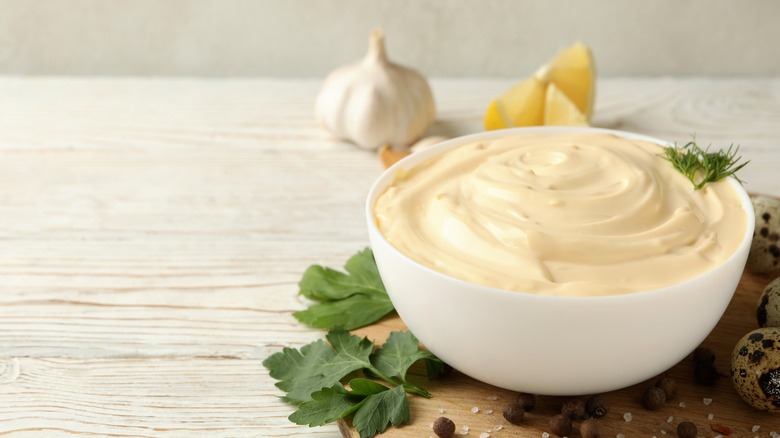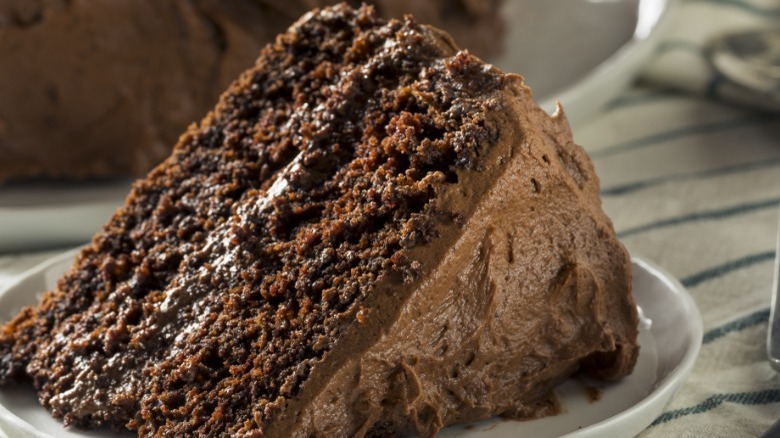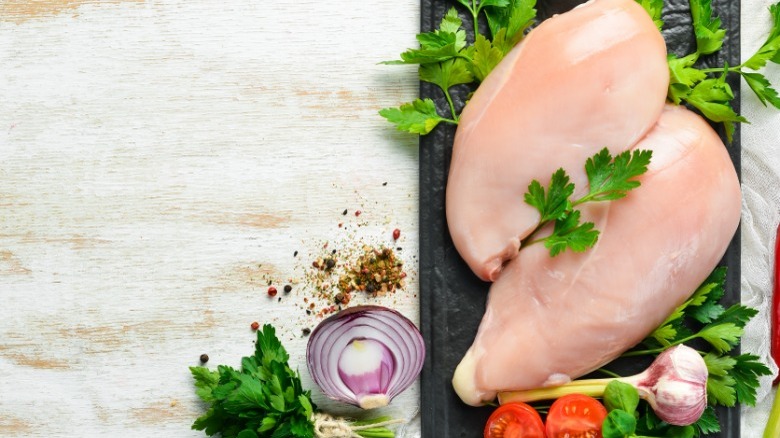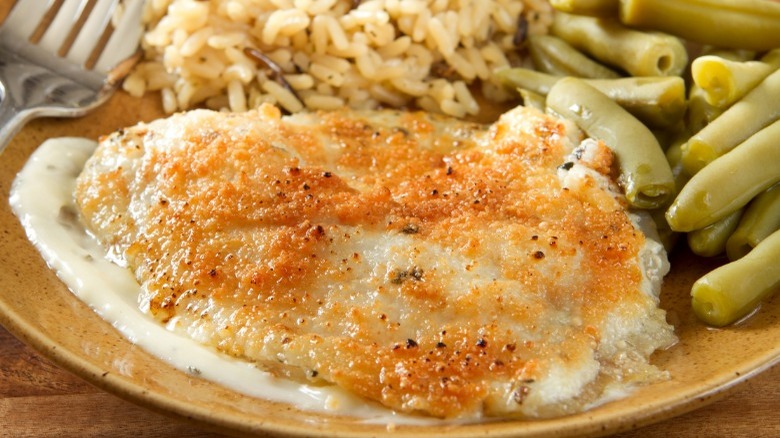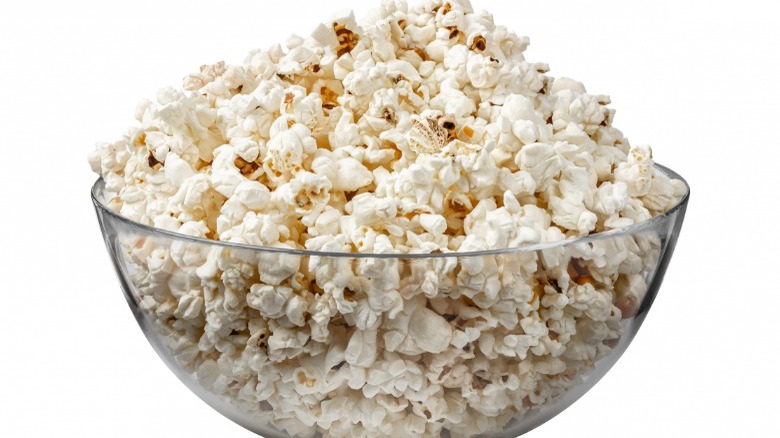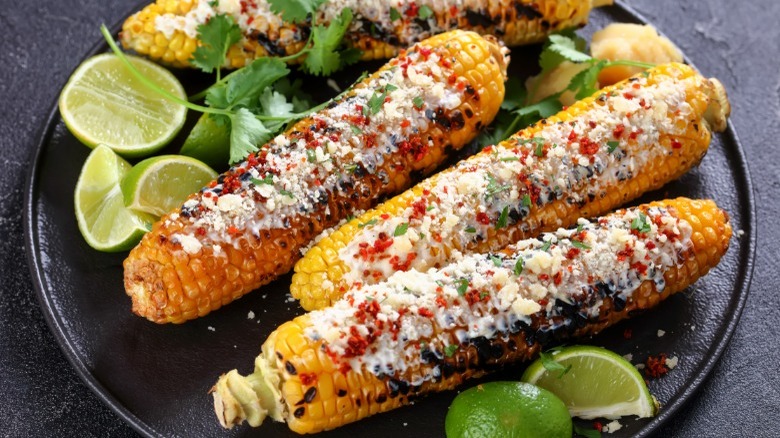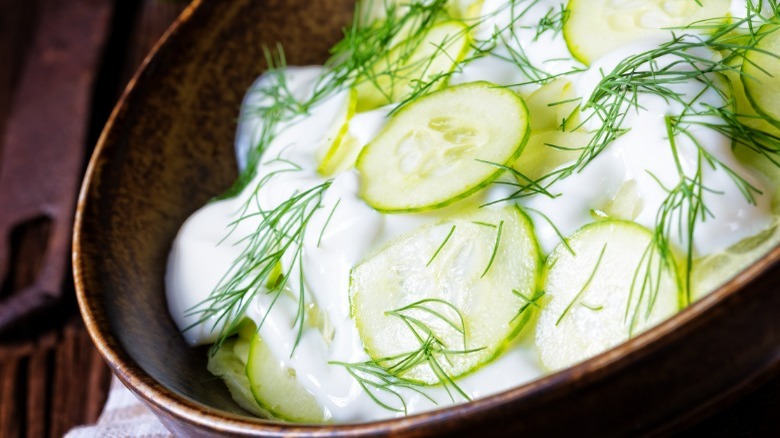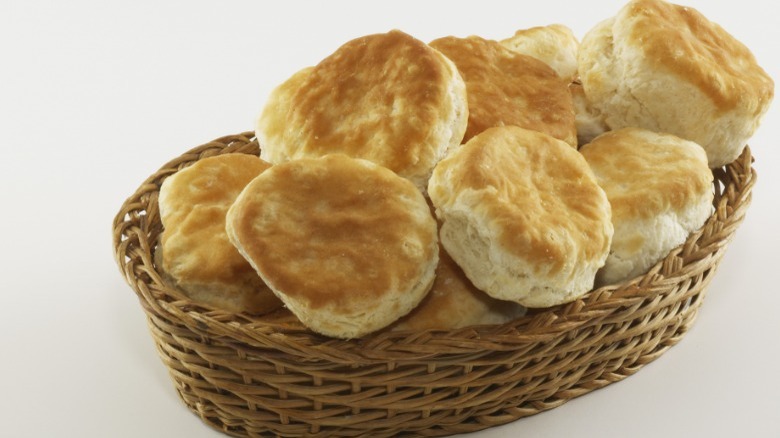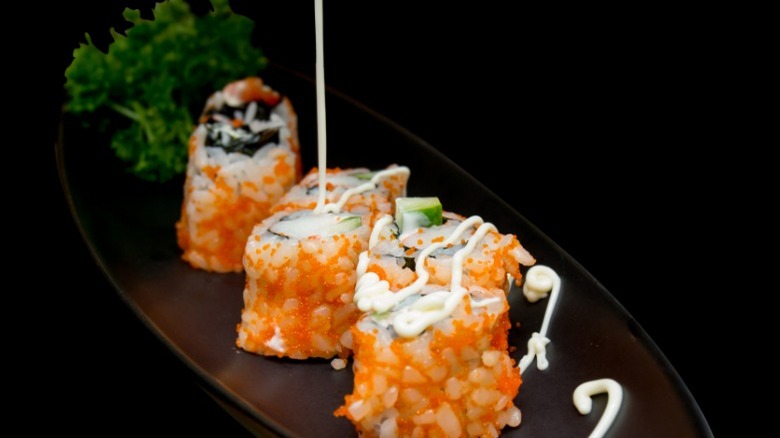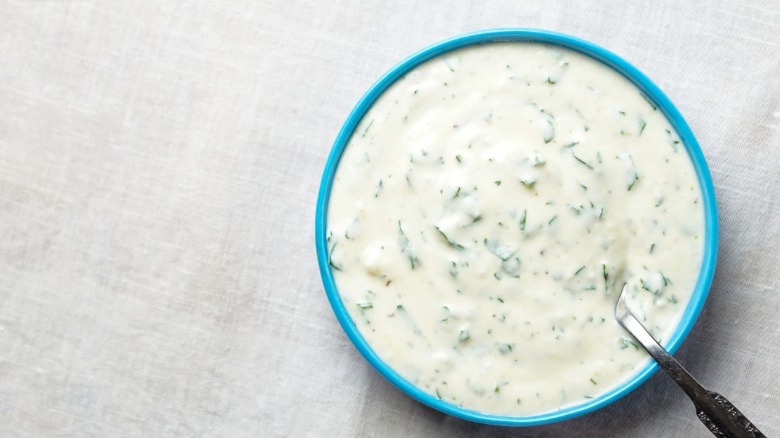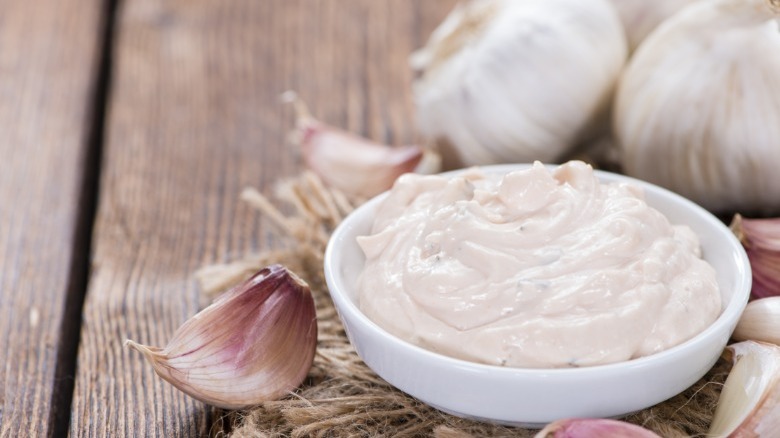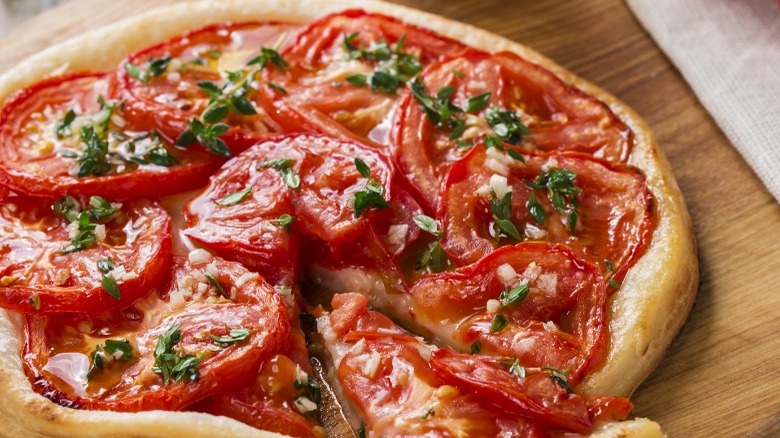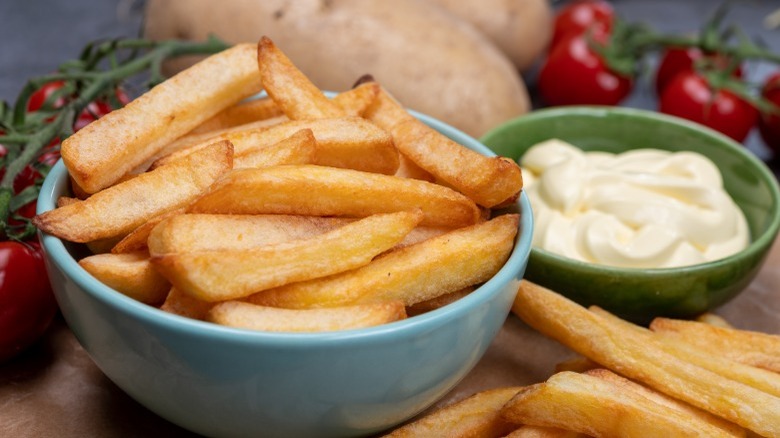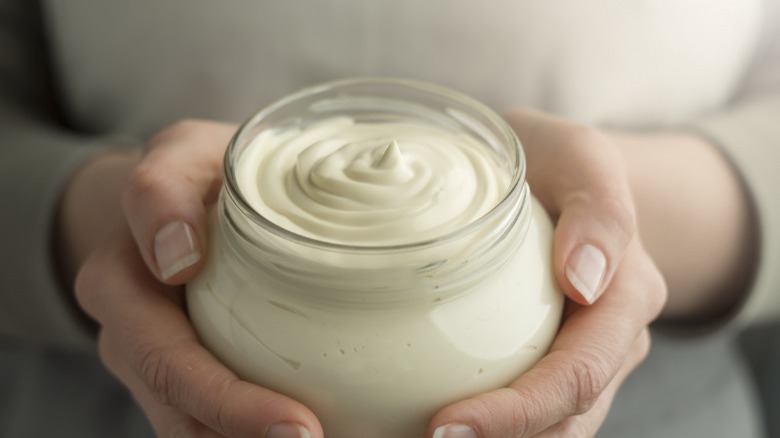13 Uses For Mayonnaise You Need To Know
Eating mayonnaise straight out of the jar might turn some people off, but those who do it have no reason to be shy. A Reddit contributor admitted to the deed and went so far as to lick the knife afterward. We won't judge, because there's just something about the creamy, tangy taste of mayo that makes it irresistible. This beloved condiment is a go-to for tuna, egg, and potato salads, and as a sandwich spread. But why limit yourself?
We're not pushing you to eat an entire jar at a time, because that would give you a stomachache. One tablespoon of Hellman's Real Mayonnaise has 10 grams of fat, with 1.5 grams saturated, according to smartlabel. That's 13 percent of the recommended daily fat value, and who uses just one tablespoon? The fat comes from soybean oil, and the other ingredients, including whole eggs, vinegar, salt, sugar, and lemon juice concentrate. Meanwhile, the brand's lighter version has 3.5 grams of fat.
Here's something else to know before we move onto some creative ways to use mayo. It's not the same thing as mayonnaise, technically. McGill Office for Science and Society explains that the FDA regulates food ingredient lists, so the word mayo refers to mayonnaise-type products. The Code of Federal Regulations specifies that mayonnaise must have egg yolk-containing ingredients, vinegar, and lemon juice, with other ingredients optional. A product labeled as mayo might have eggs in it, though, since companies use the terms interchangeably. For the fullest flavor, we recommend sticking with regular mayonnaise..
1. Use it in cake recipes
Cake batters are traditionally moistened with butter and oil, but you can swap out the latter for mayonnaise. Does that sound gross? We thought so at first but once you try it, you'll be convinced. Baking Kneads shares a few different ways to do it, and you can experiment with it until you find the right flavor and consistency.
The first option is to leave the oil and eggs out of the recipe and replace the oil with the same amount of mayonnaise. You can also make the swap and keep the eggs in there. Or if you feel a bit hesitant, start by adding a tablespoon or two of mayonnaise to the batter and see if you like the results. Don't worry about the cake tasting like mayonnaise as long as you don't add more than one full cup. Baking Kneads claims that the vinegar in the mayonnaise really brings out the flavor of chocolate, so you can try making a from-scratch chocolate cake with it or add it to a mix.
2. Add flavor to boneless chicken breasts
Boneless chicken breasts have less flavor than dark meat chicken and tend to dry out more when cooking. Trifecta explains that it's leaner than dark meat, with just three grams of fat per four-ounce serving. A four-ounce boneless chicken thigh (also white meat) has nine grams of fat, but since the dark meat gives it more flavor it doesn't need as much help.
Bone-in chicken breasts come with or without the skin, and Medical News Today posts that a 3.5-ounce serving of bone-in, skin-on chicken breast has 7.8 grams of fat per serving, and there's no denying that it adds a lot of taste. Many people leave the skin on while the chicken cooks for this reason, and remove it afterward; it can also be done when the chicken is raw. You can add mayonnaise to skinless and skin-on chicken breasts before cooking, but the boneless ones are not sold with skin.
If you're grilling boneless chicken breasts, cover both sides lightly with mayonnaise and sprinkle on your favorite dry rub. As an added bonus, the chicken won't stick to the grill. You can also measure the amount of mayonnaise you want, plop it into a bowl, and mix in your favorite spices. Want to add texture? Fold in sesame seeds and/or breadcrumbs, and horseradish for a real kick in the pants. Sanderson Farms recommends cooking boneless chicken breasts for 20 to 30 minutes at 375 degrees Fahrenheit, and the internal temperature should be at 165 degrees when you remove it from the heat.
3. Elevate your seafood recipes
Salmon and tilapia have stronger flavors than white meat chicken and also offer blank canvases that can benefit from adding mayonnaise. One option is to mix up a lemon or lime mayonnaise to spread on top of salmon burgers. All you need for this DIY condiment is ¼ cup mayonnaise, ½ teaspoon juice, and ½ teaspoon grated peel.
To create a sophisticated salmon dish, combine mayonnaise with parmesan, breadcrumbs, and other ingredients to form a paste, and spread it on top of the fish with a spoon or knife. Mayonnaise pastes work best on firm fish like the two mentioned above, as well as cod, snapper, haddock, and bass. Delicate fish like flounder and Dover sole will fall apart if you try to spread mayonnaise on them, but all hope is not lost. You can arrange this kind of lighter fish in a baking pan and set the oven to 375 degrees. Then, melt butter or margarine in a pot on low heat. As soon as it's melted, swirl in mayonnaise, fresh garlic, and your other favorite fish seasonings. Personally, we like chili powder, paprika, and Old Bay. Fun fact: mayonnaise and Old Bay are staples in Maryland crab cake recipes.
4. A fresh take on a classic treat
This snack hack is nothing new but it recently went viral on social media. This can also be categorized as gross, but keep an open mind and you'll be pleasantly surprised. After all, mayonnaise tastes great in regular corn salad. Popcorn salad can be made in a matter of minutes once you have your ingredients prepared. Think of this as a kitchen sink recipe, since you can add all kinds of things into it.
To make popcorn salad, cook a bag or two of microwave popcorn and add about ¼ to ½ of mayonnaise to a large bowl. Be sure to choose one that has enough room to mix the popcorn and add other ingredients. Yeh uses cheese-seasoned popcorn, which can work better than plain or buttered. Add in the mayonnaise, and mix gently with a large wooden spoon. Feel free to add in bite-sized, fresh vegetables like carrots, peppers, and celery. You can also add more seasoning. Finally, she also tops the salad with watercress, which adds a nice color and even more flavor.
We recommend making this salad as close to its serving time as possible since it can lose its fresh taste. Topsy's claims that popcorn gets stale faster than other foods, so cover the serving bowl until ready. And don't worry about having leftovers because people will eat this stuff like candy. We guarantee it.
5. Elevate an ordinary side dish
Corn on the cob is traditionally slathered with butter, but Mexican street corn is done up better, with mayonnaise and other ingredients. Mexicali Blue calls it elote and claims that the best way to make it is to start with grilled, charred corn. Street vendors in Mexico and other parts of the world sell the most authentic versions, served with or without the pulled-down husks that make them easier to eat; it's also served in cups.
Mexican street corn can be made with different ingredients, and the first step is to make a marinade. Add olive oil, lime juice, salt, smoked paprika, and chipotle pepper into a gallon-sized plastic bag. Put in your corn cobs, and roll them back and forth until completely covered. Then, heat up your grill to 400 degrees, and prepare the crema. Combine equal parts of mayonnaise and sour cream, two tablespoons of lime juice, half a chipotle pepper, and spices, and place the mixture in a shallow bowl. Once the corn is charred (10 to 12 minutes), remove the ears and roll them in the crema. Top with cotija cheese and cilantro right before serving.
What, does that sound too messy to eat? No worries. Shave off the kernels into a bowl when the corn has cooled enough to handle. Then, mix in the crema, cheese, and cilantro. We suggest eating this with a very large spoon or small shovel — it's that good.
6. Thicken and brighten up salads
Traditional cucumber salads are made with oil and vinegar but tend to be watery. A bit of mayonnaise will thicken that stuff right up, and you won't need to use any oil. Creamy cucumber salads have different textures and flavor profiles because of the extra ingredients. Where does the creaminess really come from, though? Equal parts of mayonnaise and sour cream. This can be combined with lemon juice, sea salt, fresh dill, and freshly ground pepper. Whisk until it's nice and smooth, and add cucumbers.
Wait — what are the best cucumbers to use?
Let's consider the options. Grow-it-Organically.com posts that slicing cucumbers have edible skins and seeds. They are medium-length and seen most often in fresh salads. Pickling cucumbers are about half that size, with dry flesh that makes them perfect for brining. Both are fine for cucumber salads, but nothing beats the revered English cucumber. They're crisp, refreshing, and slightly sweet, with almost no seeds. They are longer than the other two varieties, so they're also easier to work with. We recommend using a mandoline slicer slicer to cut cucumbers because they work so quickly and you can adjust the thickness. Fold them right into that mayonnaise-based sauce, chill for an hour, and enjoy.
7. Replace the oil/butter in rolls
Some rolls are so moist that buttering them would be a crime, but others are dry as chalk. The best way to combat that is to exchange the butter or oil in the recipe for mayonnaise. This swap is an old trick that bakers rely on, but the exchange might not work as well with cooking recipes. Tastessence simply uses the same amount of mayonnaise in place of the eggs, which is easy enough to remember.
Even though dinner rolls don't have tons of ingredients (milk, flour, yeast, etc.), they don't always come out right. Fortunately, ThermoBlog shares tips for making better dinner rolls, and covers the basics. First, make sure that all the ingredients are at room temperature, mix them up, and form the dough into a ball. The optimal temperature for the dough to rise is 70 to 77 degrees, so cover the ball with plastic wrap, place it in a greased bowl, and put it somewhere warm so the dough can rise. Once it's doubled in size, it can be formed into rolls.
Push gently on the rolls and if they don't spring back, let them rise for a little longer. ThermoBlog bakes them at 365 degrees Fahrenheit for about 20 minutes until they're lightly browned. You might consider spreading mayonnaise on them but taste them first because it won't be needed.
8. Mix up spicy sushi mayo
Sushi fans often order special rolls made with mayonnaise, either inside the fillings or on top. This is not the traditional Japanese way to do it, even if tastes amazing. Kobe Teppanyaki explains that the real thing is only made with a few main ingredients, light seasonings, and wasabi. Western sushi is all about condiments like tempura flakes, cream cheese, and mayonnaise. Bigger can certainly be better in this case, and this source concedes that both types of sushi are different but tasty.
To make sushi mayo, just add additional flavorings to regular mayonnaise. Vinegar and garlic are perfect, or you can add wasabi. You already know that the latter is pale green and super-hot, but what is it, exactly? ByFood explains that it's a root vegetable closely related to horseradish, so much so that, in fact, it's known as Japanese horseradish. Fake wasabi paste has little real wasabi in it since the stuff is so expensive. Most of the ones you see are not fully authentic, but still taste pretty good. You can make homemade wasabi mayonnaise from scratch with eggs and oil, or take the faster route by adding powdered wasabi to regular store-bought mayonnaise.
9. Turn it into a dip
Ranch dressing is the most popular kind of salad dressing in this country, but did you know that mayonnaise is one of its main ingredients? Quaint Cooking claims that it was invented in 1954 by Steve Henson, who owned Hidden Valley Ranch. That's where the name of the original ranch dressing comes from. He developed an herb mixture and added it to buttermilk and mayonnaise. People loved it, and the bottled version was introduced 30 years later. Now, ranch dressing is used as a dip, in pasta salads, on burgers, and so much more.
To make homemade ranch dressing, blend ¼ mayonnaise, ½ cup sour cream, and ½ cup buttermilk into a mixing bowl. Add in dill, parsley, onion powder, garlic powder, salt, and pepper to taste. The final touch is two teaspoons of lemon juice. Be sure to combine with a whisk and make sure that there are no remaining lumps. We like our ranch dressing served cold, so cover it tightly and keep it refrigerated until ready to serve. And don't be shy about using it, because it also pairs well with pizza, chicken fingers, and buffalo wings. Additionally, you can also use it to thicken sauces. The possibilities are endless.
10. Learn a new condiment
It might be hard to pronounce, but aioli (ay-ow-lee) is an elegant way to use mayonnaise. CHEFIN explains that it's a Mediterranean condiment, and in its purest form, does not contain eggs. That's right, it's simply made from olive oil, garlic, and salt. Garlic cloves get crushed by a mortar and pestle, and olive oil is added slowly, until a paste forms. This kind of aioli is used like mayonnaise, but tastes stronger and is obviously much oilier.
Although traditional Mediterranean aioli sauces do not contain eggs, you can make a different kind at home that tastes just as good — even if you're cheating a little. Just call it aioli, and no one will know the difference. To make a spicy aioli, thin out two cups of mayonnaise with sriracha sauce and add spices. You can also find an aioli recipe that's made with oil and swap that out for mayonnaise. You'll still need to thin it out a bit, so try water and lemon juice until you get to where you want it to be. However, don't add more oil or eggs since that's defeating the purpose.
11. Create a twist on classic pizza
We told you that mayonnaise-y ranch dressing goes great with pizza, but tomato pies can also be upgraded with mayonnaise. This dish's roots can be traced back to Philadelphia, and it's so well-loved that it earned an entry in The Encyclopedia of Greater Philadelphia. There were (and still are) a large number of Italian bakeries in the area, and tomato pies are still one of its regional delicacies. And once you make one for yourself, it will be a favorite go-to recipe.
Traditional tomato pie is usually square or rectangular, but can also be round. And instead of cheese, pepperoni, and other toppings, traditional ones have only two stars in the form of the sauce and the dough. After these pies come out of the oven, they only receive a light dusting of Parmesan or Romano cheeses. These are a real treat, but don't feel as though you can't add other toppings. Have you ever eaten a fresh tomato sandwich with mayonnaise on the bread? A homemade tomato pie topped with roasted tomatoes can be elevated with a decadent topping that combines shredded cheese and mayonnaise.
12. Find a new favorite condiment
Ketchup is probably the most popular condiment for French fries, but some people prefer dipping them into mayonnaise. You can find mayonnaise packets at fast-food restaurants like McDonald's and Wendy's, so these are good ways to try the combination for the first time. Northern Star argues that mayonnaise is better than ketchup on fries, emphasizing that the tanginess and saltiness complement one another. This source also feels that ketchup covers up the taste of the fries, and you know what? There may be some truth to that.
Should you throw away your ketchup in favor of mayonnaise? Not yet. Daily Infographic claims that the salty/sweet combination is irresistible, adding that ketchup was not always made from tomatoes. In the 18th and 19th centuries, ketchup was made from things like oysters and walnuts, which doesn't sound too bad, actually. The first French fry was a chip made in Britain in 1860, and American fast food restaurants changed things up and started calling them French fried potatoes. Modern mayonnaise was invented around the same time (the 1800s), so people may have been dunking their fries into it more than 100 years ago.
13. Use mayonnaise around the house
We couldn't end this without mentioning some of the many non-food uses of mayonnaise. Like vinegar, it is a kitchen staple that can be used for other things besides cooking and baking. Healthline mentions that the oil in mayonnaise can make for a good hair mask for those who have dry or frizzy hair. Use no more than one cup, work it into your hair, and put on a hair cap. Be sure to wash thoroughly after 20 minutes.
Music To Your Home uses mayonnaise to whiten piano keys, claiming that the bacteria in it acts as a bleaching agent. Just be sure to go over the keys with a clean, damp cloth when finished. And finally, Chefler Foods claims that mayonnaise is good for the skin and nails. It will absorb into your skin, and you can let it rest on your nails for five minutes before cleaning it off. Only use the unflavored kind, and do keep it away from your eyes.
